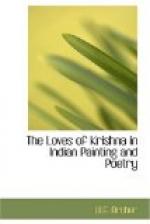But it is the path of bhakti or devotion to a personal God which commands Krishna’s strongest approval and leads him to make his startling revelation. ’Have your mind in Me, be devoted to Me. To Me shall you come. What is true I promise. Dear are you to Me. They who make Me their supreme object, they to Me are dear. Though I am the unborn, the changeless Self, I condition my nature and am born by my power. To save the good and destroy evildoers, to establish the right, I am born from age to age. He who knows this when he comes to die is not reborn but comes to Me.’ He speaks, in fact, as Vishnu himself.
This declaration is to prove the vital clue to Krishna’s character. It is to be expanded in later texts and is to account for the fervour with which he is soon to be adored. For the present, however, his claim is in the nature of an aside. After the battle, he resumes his life as a prince and it is more for his shrewdness as a councillor than his teaching as God that he is honoured and revered. Yet special majesty surrounds him and when, thirty-six years after the conflict, a hunter mistakes him for a deer and kills him by shooting him in the right foot[8], the Pandavas are inconsolable. They retreat to the Himalayas, die one by one and are translated to Indra’s heaven[9].
Such an account is obviously a great advance on the Chandogya Upanishad. Yet, as we ponder its intricate drama, we are faced with several intractable issues. It is true that a detailed character has emerged, a figure who is identified with definite actions and certain clear-cut principles. It is true also that his character as Vishnu has been asserted. But it is Krishna the feudal hero who throughout the story takes, by far, the leading part. Between this hero and Krishna the God, there is no very clear connection. The circumstances in which Vishnu has taken form as Krishna are nowhere made plain. Except on the two occasions mentioned, Krishna is apparently not recognized as God by others and does not himself claim this status. Indeed it is virtually only as an afterthought that the epic is used to transmit his great sermon, and almost by accident that he becomes the most significant figure




